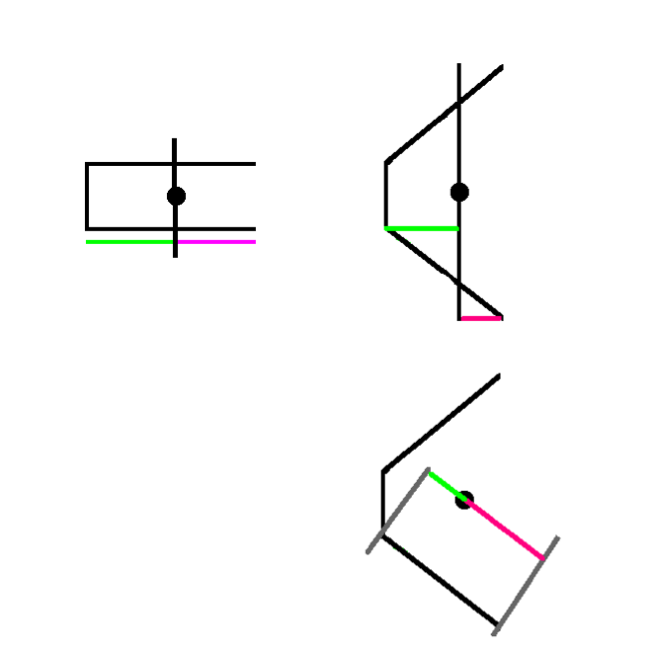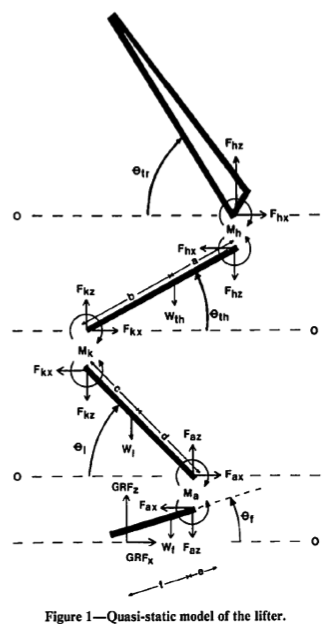Calculating Joint Moments in the Squat
Here’s a complicated biomechanical article on the squat from my colleague Andrew Vigotsky (my former intern who is now smarter than me LOL). Hopefully some of you will be able to understand and enjoy it. Cliff notes: the way most of us fitness bros estimate hip and knee extension torques in a squat is oversimplified and erroneous. I still believe it provides a reasonable estimation for narrow stance squatting, but Andrew makes some great points in this article. Down the road Andrew and I will compare calculations to see how far off the methods are in torques.
Calculating Joint Moments in the Squat
By Andrew Vigotsky
For many years, people in the fitness industry have calculated joint moments in the squat using the floor reaction force vector (FRFV) method or by assuming the external load is the only force inducing a moment (Figure 1). This method, however, is erroneous for a number of reasons (Winter 2009).

Figure 1. Calculation of knee and hip external moment arms using the floor reaction force method or barbell location method. The dashed line represents the ground reaction force, floor reaction force, or center of gravity of the barbell.
- Those who utilize the FRFV method often assume the lifter’s center of pressure is the midfoot. However, this has been shown not to be the case, as lifters tend to shift their center of pressure anteriorly during the later phases of the movement (Dionisio et al. 2008).
- The traditional FRFV method is myopic in that it only examines the sagittal plane. Two-dimensional kinetic analyses become less valid with wider stances and more horizontal abduction (Escamilla et al. 2001), as the other planes cannot be ignored. So, while some believe that hip and knee moment requisites decrease with wider stances, this is not the case. In actuality, it appears that widening one’s stance increases the knee moment arm and decreases the hip moment arm, but only by about 3 cm (Escamilla et al. 2001).
- This method ignores superincumbent weight and how joint reaction forces and segmental moments of inertia affect joint moments. These differences are summated in multisegmental models and, especially during dynamic movements, lead to erroneous interpretations of joint moments (Winter 2009) (Figure 2). In reality, inverse quasi-static or dynamic analyses are needed for more accurate calculations. However, in the squat, this may not be as relevant.

Figure 2. FRFV may lead to erroneous interpretations of joint moments as you go up the kinetic chain. This would imply that walking would require some serious neck strength (torque)!
Proper inverse quasi-static analysis of the squat has been shown to be 99% as effective as inverse dynamic analyses (Lander et al. 1990), and is much, much easier to conduct, as segmental angular accelerations may be ignored. Such analyses can be performed using the ground reaction force, segment angles relative to horizontal, segment lengths, segment masses, and segment center of masses (Figure 3). This is, however, much more intense than the FRFV method described above. So, in an effort to increase the validity of the FRFV, it is important that other planes (i.e., transverse plane) be taken into account when attempting to calculate knee and hip moments. In order to take these into account, the joint center must be extrapolated into space, such that the force from the load is perpendicular to it. Only then can the moment arms and moments be calculated (Figure 4).

Figure 4. Aerial View – Top left: narrow stance squat in the transverse plane with moment arms drawn in the sagittal plane. Top right: wide stance squat with moment arms drawn in the sagittal plane. Bottom right: wide stance squat with moment arms drawn in the plane of the joint axes of rotation.
From Figure 4, it can clearly be seen that only examining the sagittal plane can be misleading. These figures are supported by Winter’s support moment theory, in addition to the findings of Escamilla et al. (2001), wherein horizontal abduction resulted in similar summed moment arms, but a bias for a larger moment arm about the knee.
This is one simple example of how biomechanics is not as simple as many may think. In this case, because humans move in three dimensions, calculating things using two dimensions may be shortsighted.
References
Dionisio VC, Almeida GL, Duarte M, and Hirata RP. 2008. Kinematic, kinetic and EMG patterns during downward squatting. Journal of Electromyography and Kinesiology 18:134-143.
Escamilla RF, Fleisig GS, Lowry TM, Barrentine SW, and Andrews JR. 2001. A three-dimensional biomechanical analysis of the squat during varying stance widths. Medicine and Science in Sports and Exercise 33:984-998.
Lander JE, Simonton RL, and Giacobbe JK. 1990. The effectiveness of weight-belts during the squat exercise. Medicine and Science in Sports and Exercise 22:117-126.
Winter DA. 2009. Biomechanics and Motor Control of Human Movement: Wiley.
The post Calculating Joint Moments in the Squat appeared first on Bret Contreras.



Leave a comment